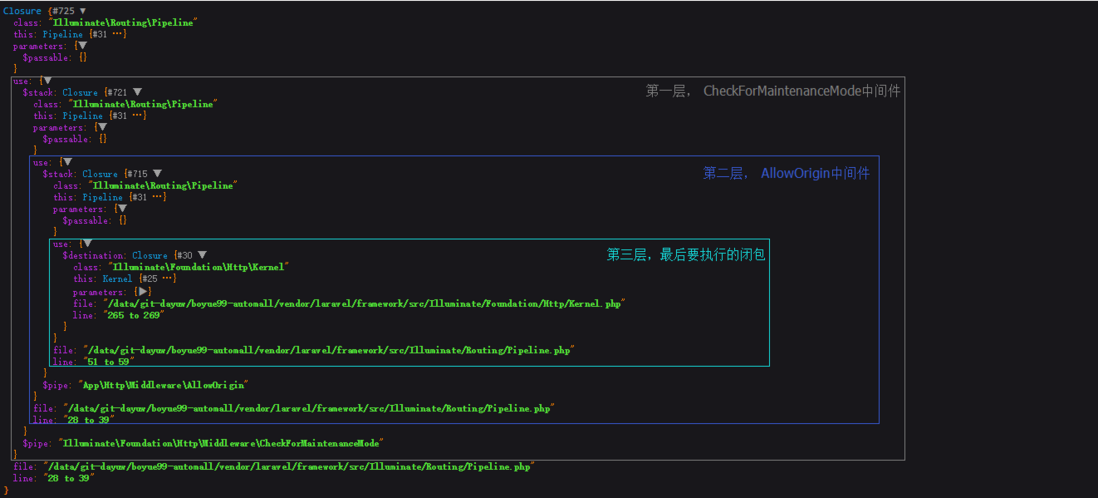简介
Laravel 中间件提供了一种方便的机制来过滤进入应用的 HTTP 请求, 如
ValidatePostSize用来验证POST请求体大小、ThrottleRequests用于限制请求频率等。
那Laravel的中间件是怎样工作的呢?
启动流程
再说Laravel中间件前,我们先来理一理laravel的启动流程
首先,入口文件index.php加载了autoload和引导文件bootstrap
require __DIR__.'/../bootstrap/autoload.php';
$app = require_once __DIR__.'/../bootstrap/app.php';并在引导文件bootstrap/app.php中初始化了Application实例
$app = new Illuminate\Foundation\Application(
realpath(__DIR__.'/../')
);我们先跳过如何初始化Application(后面会有简单介绍),再回到入口文件(index.php)中,通过从Application实例$app中获取Http Kernel对象来执行handle方法,换取response。
$kernel = $app->make(Illuminate\Contracts\Http\Kernel::class);
$response = $kernel->handle(
$request = Illuminate\Http\Request::capture()
);
$response->send();
$kernel->terminate($request, $response);换取响应后,把响应内容返回给Client,并执行后续操作(terminate,如关闭session等)。
实例化Application:
Laravel的容器并不是我这次说的重点,这里简单介绍下
在初始化Application(启动容器)时,Laravel主要做了三件事情
注册基础绑定
注册基础服务提供者
注册容器核心别名
注册完成以后,我们就能直接从容器中获取需要的对象(如Illuminate\\Contracts\\Http\\Kernel),即使它是一个Interface。
获取Illuminate\Contracts\Http\Kernel类时,我们得到的真正实例是 AppHttpKernel
// bootstrap/app.php
$app->singleton(
Illuminate\Contracts\Http\Kernel::class,
App\Http\Kernel::class
);Laravel容器请参考
Handle
从容器中获得Http Kernel对象后,Laravel通过执行kernel->handle来换取response对象。
//Illuminate\Foundation\Http\Kernel.php
public function handle($request)
{
$request->enableHttpMethodParameterOverride();
$response = $this->sendRequestThroughRouter($request);
//......
}enableHttpMethodParameterOverride方法开启方法参数覆盖,即可以在POST请求中添加_method参数来伪造HTTP方法(如post中添加_method=DELETE来构造HTTP DELETE请求)。
然后Laravel把请求对象(request)通过管道流操作。
protected function sendRequestThroughRouter($request)
{
return (new Pipeline($this->app))
->send($request)
->through($this->app->shouldSkipMiddleware() ? [] : $this->middleware)
->then($this->dispatchToRouter());
}
/**
* Get the route dispatcher callback.
*
* @return \Closure
*/
protected function dispatchToRouter()
{
return function ($request) {
$this->app->instance('request', $request);
return $this->router->dispatch($request);
};
}Pipeline是laravel的管道操作类。在这个方法中,我的理解是:发送一个$request对象通过middleware中间件数组,最后在执行dispatchToRouter方法。注意,这里的中间件只是全局中间件。即首先让Request通过全局中间件,然后在路由转发中($this->dispatchToRouter()),再通过路由中间件及中间件group。
所以,到这里为止,Laravel的请求交给了Pipeline管理,让我们来看看这个Pipeline究竟是怎样处理的。
//Illuminate\Pipeline\Pipeline.php
public function then(Closure $destination)
{
$pipeline = array_reduce(
array_reverse($this->pipes), $this->carry(), $this->prepareDestination($destination)
);
return $pipeline($this->passable);
}
protected function prepareDestination(Closure $destination)
{
return function ($passable) use ($destination) {
return $destination($passable);
};
}
protected function carry()
{
return function ($stack, $pipe) {
return function ($passable) use ($stack, $pipe) {
if ($pipe instanceof Closure) {
return $pipe($passable, $stack);
} elseif (! is_object($pipe)) {
list($name, $parameters) = $this->parsePipeString($pipe);
$pipe = $this->getContainer()->make($name);
$parameters = array_merge([$passable, $stack], $parameters);
} else {
$parameters = [$passable, $stack];
}
return $pipe->{$this->method}(...$parameters);
};
};
}我们来看看最重要的then方法, 在这方法中$destination表示通过该管道最后要执行的Closure(即上述的dispatchToRouter方法)。passable表示被通过管道的对象Request。
php内置方法array_reduce把所有要通过的中间件($this->pipes)都通过carry方法($this->pipes不为空时)并压缩为一个Closure。最后在执行prepareDestination。
array_reduce($pipes, callback($stack, $pipe), $destination), 当pipes为空时,直接执行destination,否则将所有
$pipes压缩为一个Closure,最后在执行destination。
列如我有两个中间件
Illuminate\Foundation\Http\Middleware\CheckForMaintenanceMode::class,
App\Http\Middleware\AllowOrigin::class,//自定义中间件将这两个中间件通过array_reduce方法时,返回压缩后的Closure如:
该Closure共有三个层, 前面两个为两个中间件,后面个位最后要执行的Closure(即上述的dispatchToRouter方法)。
//中间件handle
public function handle($request, Closure $next)
{
}在第一个通过的中间件(此处是CheckForMaintenanceMode)handle方法中,dump($next)如下
在第二个通过的中间件(共两个,此处是AllowOrigin)handle方法中,dump($next)如下
由此可知,中间件在执行$next($request)时,表示该中间件已正常通过,并期待继续执行下一个中间件。直到所有中间件都执行完毕,最后在执行最后的destination(即上述的dispatchToRouter方法)
如果上述
array_reduce有地方难懂的,可以参考这边文章PHP 内置函数 array_reduce 在 Laravel 中的使用
以上是Laravel在通过全局中间件时的大致流程,通过中间件group和路由中间件也是一样的, 都是采用管道流操作,详情可翻阅源码
Illuminate\Routing\Router->runRouteWithinStack





**粗体** _斜体_ [链接](http://example.com) `代码` - 列表 > 引用。你还可以使用@来通知其他用户。